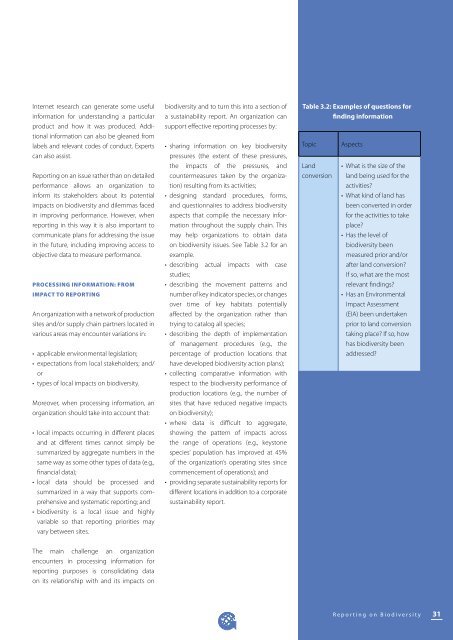Biodiversity - a GRI Reporting Resource - Global Reporting Initiative
Biodiversity - a GRI Reporting Resource - Global Reporting Initiative
Biodiversity - a GRI Reporting Resource - Global Reporting Initiative
You also want an ePaper? Increase the reach of your titles
YUMPU automatically turns print PDFs into web optimized ePapers that Google loves.
Internet research can generate some useful<br />
information for understanding a particular<br />
product and how it was produced. Additional<br />
information can also be gleaned from<br />
labels and relevant codes of conduct. Experts<br />
can also assist.<br />
<strong>Reporting</strong> on an issue rather than on detailed<br />
performance allows an organization to<br />
inform its stakeholders about its potential<br />
impacts on biodiversity and dilemmas faced<br />
in improving performance. However, when<br />
reporting in this way it is also important to<br />
communicate plans for addressing the issue<br />
in the future, including improving access to<br />
objective data to measure performance.<br />
PROCESSING INFORMATION: FROM<br />
IMPACT TO REPORTING<br />
An organization with a network of production<br />
sites and/or supply chain partners located in<br />
various areas may encounter variations in:<br />
• applicable environmental legislation;<br />
• expectations from local stakeholders; and/<br />
or<br />
• types of local impacts on biodiversity.<br />
Moreover, when processing information, an<br />
organization should take into account that:<br />
• local impacts occurring in different places<br />
and at different times cannot simply be<br />
summarized by aggregate numbers in the<br />
same way as some other types of data (e.g.,<br />
financial data);<br />
• local data should be processed and<br />
summarized in a way that supports comprehensive<br />
and systematic reporting; and<br />
• biodiversity is a local issue and highly<br />
variable so that reporting priorities may<br />
vary between sites.<br />
biodiversity and to turn this into a section of<br />
a sustainability report. An organization can<br />
support effective reporting processes by:<br />
• sharing information on key biodiversity<br />
pressures (the extent of these pressures,<br />
the impacts of the pressures, and<br />
countermeasures taken by the organization)<br />
resulting from its activities;<br />
• designing standard procedures, forms,<br />
and questionnaires to address biodiversity<br />
aspects that compile the necessary information<br />
throughout the supply chain. This<br />
may help organizations to obtain data<br />
on biodiversity issues. See Table 3.2 for an<br />
example.<br />
• describing actual impacts with case<br />
studies;<br />
• describing the movement patterns and<br />
number of key indicator species, or changes<br />
over time of key habitats potentially<br />
affected by the organization rather than<br />
trying to catalog all species;<br />
• describing the depth of implementation<br />
of management procedures (e.g., the<br />
percentage of production locations that<br />
have developed biodiversity action plans);<br />
• collecting comparative information with<br />
respect to the biodiversity performance of<br />
production locations (e.g., the number of<br />
sites that have reduced negative impacts<br />
on biodiversity);<br />
• where data is difficult to aggregate,<br />
showing the pattern of impacts across<br />
the range of operations (e.g., keystone<br />
species’ population has improved at 45%<br />
of the organization’s operating sites since<br />
commencement of operations); and<br />
• providing separate sustainability reports for<br />
different locations in addition to a corporate<br />
sustainability report.<br />
Table 3.2: Examples of questions for<br />
finding information<br />
Topic<br />
Land<br />
conversion<br />
Aspects<br />
• What is the size of the<br />
land being used for the<br />
activities?<br />
• What kind of land has<br />
been converted in order<br />
for the activities to take<br />
place?<br />
• Has the level of<br />
biodiversity been<br />
measured prior and/or<br />
after land conversion?<br />
If so, what are the most<br />
relevant findings?<br />
• Has an Environmental<br />
Impact Assessment<br />
(EIA) been undertaken<br />
prior to land conversion<br />
taking place? If so, how<br />
has biodiversity been<br />
addressed?<br />
The main challenge an organization<br />
encounters in processing information for<br />
reporting purposes is consolidating data<br />
on its relationship with and its impacts on<br />
R e p o r t i n g o n B i o d i v e r s i t y<br />
31

















